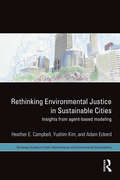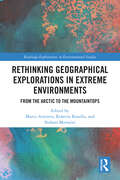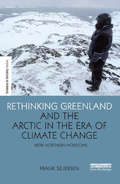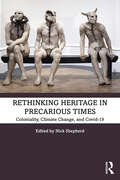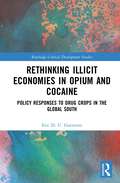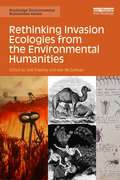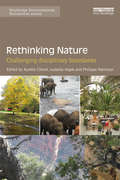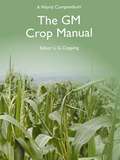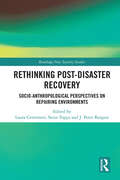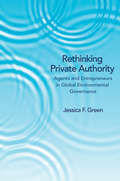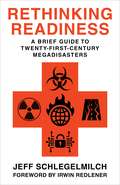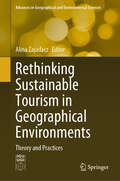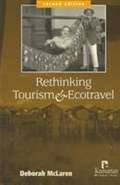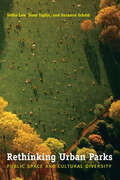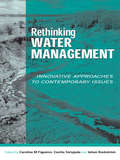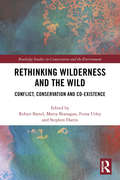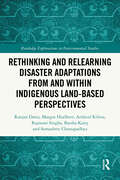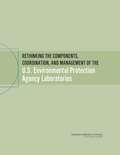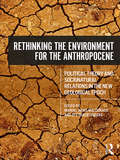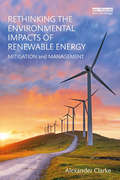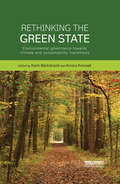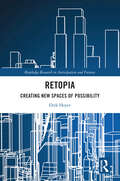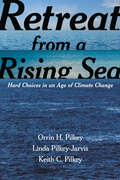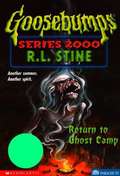- Table View
- List View
Rethinking Environmental Justice in Sustainable Cities: Insights from Agent-Based Modeling (Routledge Studies in Public Administration and Environmental Sustainability)
by Heather E. Campbell Yushim Kim Adam M. EckerdAs the study of environmental policy and justice becomes increasingly significant in today’s global climate, standard statistical approaches to gathering data have become less helpful at generating new insights and possibilities. None of the conventional frameworks easily allow for the empirical modeling of the interactions of all the actors involved, or for the emergence of outcomes unintended by the actors. The existing frameworks account for the "what," but not for the "why." Heather E. Campbell, Yushim Kim, and Adam Eckerd bring an innovative perspective to environmental justice research. Their approach adjusts the narrower questions often asked in the study of environmental justice, expanding to broader investigations of how and why environmental inequities occur. Using agent-based modeling (ABM), they study the interactions and interdependencies among different agents such as firms, residents, and government institutions. Through simulation, the authors test underlying assumptions in environmental justice and discover ways to modify existing theories to better explain why environmental injustice occurs. Furthermore, they use ABM to generate empirically testable hypotheses, which they employ to check if their simulated findings are supported in the real world using real data. The pioneering research on environmental justice in this text will have effects on the field of environmental policy as a whole. For social science and policy researchers, this book explores how to employ new and experimental methods of inquiry on challenging social problems, and for the field of environmental justice, the authors demonstrate how ABM helps illuminate the complex social and policy interactions that lead to both environmental justice and injustice.
Rethinking Geographical Explorations in Extreme Environments: From the Arctic to the Mountaintops (Routledge Explorations in Environmental Studies)
by Marco Armiero Roberta Biasillo Stefano MorosiniFocusing on extreme environments, from Umberto Nobile’s expedition to the Arctic to the commercialization of Mt Everest, this volume examines global environmental margins, how they are conceived and how perceptions have changed. Mountaintops and Arctic environments are the settings of social encounters, political strategies, individual enterprises, geopolitical tensions, decolonial practises, and scientific experiments. Concentrating on mountaineering and Arctic exploration between 1880 – 1960, contributors to this volume show how environmental marginalisation has been discursively implemented and materially generated by foreign and local actors. It examines to what extent the status and identity of extreme environments has changed during modern times, moving them from periphery to the centre and discarding their marginality. The first section looks at ways in which societies have framed remoteness, through the lens of commercialization, colonialism, knowledge production and sport, while the second examines the reverse transfer, focusing on how extreme nature has influenced societies, through international network creation, political consensus and identity building. This collection enriches the historical understanding of exploration by adopting a critical approach and offering multidimensional and multi-gaze reconstructions. This book is essential reading for students and scholars interested in environmental history, geography, colonial studies and the environmental humanities.
Rethinking Greenland and the Arctic in the Era of Climate Change: New Northern Horizons (The Earthscan Science in Society Series)
by Frank SejersenThis ground-breaking book investigates how Arctic indigenous communities deal with the challenges of climate change and how they strive to develop self-determination. Adopting an anthropological focus on Greenland’s vision to boost extractive industries and transform society, the book examines how indigenous communities engage with climate change and development discourses. It applies a critical and comparative approach, integrating both local perspectives and adaptation research from Canada and Greenland to make the case for recasting the way the Arctic and Inuit are approached conceptually and politically. The emphasis on indigenous peoples as future-makers and right-holders paves the way for a new understanding of the concept of indigenous knowledge and a more sensitive appreciation of predicaments and dynamics in the Arctic. This book will be of interest to post-graduate students and researchers in environmental studies, development studies and area studies.
Rethinking Heritage in Precarious Times: Coloniality, Climate Change, and Covid-19
by Nick ShepherdRethinking Heritage in Precarious Times sets a fresh agenda for Heritage Studies by reflecting upon the unprecedented nature of the contemporary moment. In doing so, the volume also calls into question established ideas, ways of working, and understandings of the future. Presenting contributions by leading figures in the field of Heritage Studies, Indigenous scholars, and scholars from across the global north and global south, the volume engages with the most pressing issues of today: coloniality, the climate emergency, the Covid-19 pandemic, structural racism, growing social and economic inequality, and the ongoing struggle for dignity and restitution.Considering the impact of climate change, chapters re-imagine museums for climate action, explore the notion of a world heritage for the Anthropocene, and reflect on heritage and posthumanism. Drawing inspiration from the global demonstrations against racism, police violence and authoritarianism, chapters explore the notion of a people’s heritage, draw on local and Indigenous conceptualizations to lay out a notion of heritage in the service of social justice and restitution, and detail the precariousness of universities and heritage institutions in the global south. Analysing the ongoing impact of the Covid-19 pandemic, chapters also explore the changing nature of life under lockdown, describe its effects on theories of urbanity, and reflect on emergent Covidsocialities and heritage-in-the-making. Rethinking Heritage in Precarious Times argues that we need the deep-time perspective that Heritage Studies offers, as well as its sense of transgenerational conversations andaccountabilities, in order to respond to these many challenges—and to craft open,creative, and inclusive futures. It will be essential reading for academics and studentsengaged in the study of heritage, anthropology, memory, history, and geography.
Rethinking Illicit Economies in Opium and Cocaine: Policy Responses to Drug Crops in the Global South (Routledge Critical Development Studies)
by Eric D. GutierrezThis book investigates the cross-border trade in illicit drug crops in the global south. It exposes an important paradox: despite all the dangers and negative consequences of these criminal networks, in many cases, they also provide marginalised and excluded communities with important private sources of protection, investment, and employment. This book reconstructs and compares socioeconomic contexts, criminal careers, and changes in farmgate prices of illicit coca and opium poppy crops in Afghanistan, Myanmar, Colombia, and Bolivia. It investigates the politics of strange bedfellows; informal bankers-without-suits providing cross-border financial services to the undocumented and the unbanked; the criminals without borders; and the mystery of illicit crop prices. The book challenges commonly held assumptions and casts new light on how relationships of conflict and accommodation are arranged and re-arranged in fluid, ever-changing contexts, producing often paradoxical outcomes. It then suggests policy reforms and alternative approaches to drug policy, development aid, and peacebuilding work. Researchers and students across development, peacebuilding, illicit economies, and conflict studies will find this book an important source of original research and analysis. It will also be useful for politicians, commentators and public officials considering what to do differently in tackling illicit drug economies.
Rethinking Invasion Ecologies from the Environmental Humanities: Rethinking Invasion Ecologies From The Environmental Humanities (Routledge Environmental Humanities)
by Iain McCalman Jodi FrawleyResearch from a humanist perspective has much to offer in interrogating the social and cultural ramifications of invasion ecologies. The impossibility of securing national boundaries against accidental transfer and the unpredictable climatic changes of our time have introduced new dimensions and hazards to this old issue. Written by a team of international scholars, this book allows us to rethink the impact on national, regional or local ecologies of the deliberate or accidental introduction of foreign species, plant and animal. Modern environmental approaches that treat nature with naïve realism or mobilize it as a moral absolute, unaware or unwilling to accept that it is informed by specific cultural and temporal values, are doomed to fail. Instead, this book shows that we need to understand the complex interactions of ecologies and societies in the past, present and future over the Anthropocene, in order to address problems of the global environmental crisis. It demonstrates how humanistic methods and disciplines can be used to bring fresh clarity and perspective on this long vexed aspect of environmental thought and practice. <P><P>Students and researchers in environmental studies, invasion ecology, conservation biology, environmental ethics, environmental history and environmental policy will welcome this major contribution to environmental humanities.
Rethinking Nature: Challenging Disciplinary Boundaries (Routledge Environmental Humanities)
by Aurélie Choné Isabelle Hajek Philippe HammanContemporary ideas of nature were largely shaped by schools of thought from Western cultural history and philosophy until the present-day concerns with environmental change and biodiversity conservation. There are many different ways of conceptualising nature in epistemological terms, reflecting the tensions between the polarities of humans as masters or protectors of nature and as part of or outside of nature. The book shows how nature is today the focus of numerous debates, calling for an approach which goes beyond the merely technical or scientific. It adopts a threefold – critical, historical and cross-disciplinary – approach in order to summarise the current state of knowledge. It includes contributions informed by the humanities (especially history, literature and philosophy) and social sciences, concerned with the production and circulation of knowledge about "nature" across disciplines and across national and cultural spaces. The volume also demonstrates the ongoing reconfiguration of subject disciplines, as seen in the recent emergence of new interdisciplinary approaches and the popularity of the prefix "eco-" (e.g. ecocriticism, ecospirituality, ecosophy and ecofeminism, as well as subdivisions of ecology, including urban ecology, industrial ecology and ecosystem services). Each chapter provides a concise overview of its topic which will serve as a helpful introduction to students and a source of easy reference.? This text is also valuable reading for researchers interested in philosophy, sociology, anthropology, geography, ecology, politics and all their respective environmentalist strands.
Rethinking Park Protection
by Will LapageIn today's society, hidden beliefs can subtly guide the management of parks, such as treating them as natural resources rather than national assets. Resulting management practices often lead to deferred maintenance on park infrastructure, causing inadequate protection from vandalism, poaching, and theft of artefacts. A sad demise, often due to an out-dated belief that parks are non-essential leisure services rather than necessities for a vibrant modern life. This book challenges the reader to examine the core beliefs that created our public parklands, comparing them with the beliefs that guide contemporary park stewardship in an effort to improve the management of parks and reassess their purpose in modern life.
Rethinking Post-Disaster Recovery: Socio-Anthropological Perspectives on Repairing Environments (Routledge New Security Studies)
by J. Peter Burgess Sezin Topçu Laura CentemeriThis book presents an original interdisciplinary approach to the study of the so-called ‘recovery phase’ in disaster management, centered on the notion of repairing. The volume advances thinking on disaster recovery that goes beyond institutional and managerial challenges, descriptions, and analyses. It encourages socially, politically, and ethically engaged questioning of what it means to recover after disaster. At the center of this analysis, contributions examine the diversity of processes of repairing through which recovery can take place, and the varied meanings actors attribute to repair at different times and scales of such processes. It also analyses the multiple arenas (juridical, expert, political) in which actors are engaged in struggles of sense-making over the "what-ness" of a disaster and the paths for recovery. These struggles are interlinked with interest-based and power-based ones which maintain structural conditions of inequality and exploitation, pre-existing social hierarchies and established forms of marginality. The work uses case studies from all over the world, cutting-edge theoretical discussions, and original empirical research to put critical and interpretative approaches in social sciences into dialogue, opening the venue for innovative approaches in the study of environmental disasters. This book will be of much interest to students of disaster management, sociology, anthropology, law and philosophy.
Rethinking Private Authority: Agents and Entrepreneurs in Global Environmental Governance
by Jessica F. GreenRethinking Private Authority examines the role of non-state actors in global environmental politics, arguing that a fuller understanding of their role requires a new way of conceptualizing private authority. Jessica Green identifies two distinct forms of private authority--one in which states delegate authority to private actors, and another in which entrepreneurial actors generate their own rules, persuading others to adopt them. Drawing on a wealth of empirical evidence spanning a century of environmental rule making, Green shows how the delegation of authority to private actors has played a small but consistent role in multilateral environmental agreements over the past fifty years, largely in the area of treaty implementation. This contrasts with entrepreneurial authority, where most private environmental rules have been created in the past two decades. Green traces how this dynamic and fast-growing form of private authority is becoming increasingly common in areas ranging from organic food to green building practices to sustainable tourism. She persuasively argues that the configuration of state preferences and the existing institutional landscape are paramount to explaining why private authority emerges and assumes the form that it does. In-depth cases on climate change provide evidence for her arguments. Groundbreaking in scope, Rethinking Private Authority demonstrates that authority in world politics is diffused across multiple levels and diverse actors, and it offers a more complete picture of how private actors are helping to shape our response to today's most pressing environmental problems.
Rethinking Readiness: A Brief Guide to Twenty-First-Century Megadisasters
by Professor Jeffrey SchlegelmilchAs human society continues to develop, we have increased the risk of large-scale disasters. From health care to infrastructure to national security, systems designed to keep us safe have also heightened the potential for catastrophe. The constant pressure of climate change, geopolitical conflict, and our tendency to ignore what is hard to grasp exacerbates potential dangers. How can we prepare for and prevent the twenty-first-century disasters on the horizon?Rethinking Readiness offers an expert introduction to human-made threats and vulnerabilities, with a focus on opportunities to reimagine how we approach disaster preparedness. Jeff Schlegelmilch identifies and explores the most critical threats facing the world today, detailing the dangers of pandemics, climate change, infrastructure collapse, cyberattacks, and nuclear conflict. Drawing on the latest research from leading experts, he provides an accessible overview of the causes and potential effects of these looming megadisasters. The book highlights the potential for building resilient, adaptable, and sustainable systems so that we can be better prepared to respond to and recover from future crises. Thoroughly grounded in scientific and policy expertise, Rethinking Readiness is an essential guide to this century’s biggest challenges in disaster management.
Rethinking Sustainable Tourism in Geographical Environments: Theory and Practices (Advances in Geographical and Environmental Sciences)
by Alina ZajadaczThis book covers the current escalation of social problems related to the unstable political situation, economic crisis, as well as growing problems related to the state of the natural environment (existential climate crisis; pollution of land, oceans, and the atmosphere; severe declines in biodiversity) which requires a new rethinking of the sustainable tourism paradigm, in relation to the realities of the modern world, based on the practices observed in the tourist services sector. „Tourism is like fire, you can cook food on it, you can also burn down your house”—says the proverb. On the one hand, it allows for the regeneration of physical and mental strength of visitors, as well as provides funds for the economic development of the destination, but on the other hand, it contributes to a lot of damage to the geographical environment. The period of "stopping" of tourism during the lockdown caused by the COVID-19 pandemic allowed many areas to be relieved of the tourist traffic, which resulted in the observed revitalization of the natural environment, but also huge social and economic problems in destinations that are largely dependent on income from tourism. The rapid resurgence of tourism after the pandemic restored revenues but also caused many social tensions. The problem of overtourism returned, and residents protested, calling for "tourists to go home." The entire tourism system requires a thorough analysis of the complex consequences of its development. This book presents many challenges facing contemporary tourism. Its theoretical and practical aspects provide a useful knowledge base for both researchers studying changes in tourism and practitioners in the tourism services sector. The content also serves as an inspiration to search for optimal solutions aimed at the sustainable development of contemporary and future tourism.
Rethinking Tourism and Ecotravel
by Deborah McLarenA fully revised and comprehensive overview of the history and global development of tourism, often considered the largest industry in the world. Despite promising great benefits to hosts and guests alike, tourism has often resulted in some very stark and painful consequences for local host communities and the environment.
Rethinking Urban Parks: Public Space and Cultural Diversity
by Setha LowUrban parks such as New York City's Central Park provide vital public spaces where city dwellers of all races and classes can mingle safely while enjoying a variety of recreations. By coming together in these relaxed settings, different groups become comfortable with each other, thereby strengthening their communities and the democratic fabric of society. But just the opposite happens when, by design or in ignorance, parks are made inhospitable to certain groups of people. This pathfinding book argues that cultural diversity should be a key goal in designing and maintaining urban parks. Using case studies of New York City's Prospect Park, Orchard Beach in Pelham Bay Park, and Jacob Riis Park in the Gateway National Recreation Area, as well as New York's Ellis Island Bridge Proposal and Philadelphia's Independence National Historical Park, the authors identify specific ways to promote, maintain, and manage cultural diversity in urban parks. They also uncover the factors that can limit park use, including historical interpretive materials that ignore the contributions of different ethnic groups, high entrance or access fees, park usage rules that restrict ethnic activities, and park “restorations” that focus only on historical or aesthetic values. With the wealth of data in this book, urban planners, park professionals, and all concerned citizens will have the tools to create and maintain public parks that serve the needs and interests of all the public.
Rethinking Water Management: Innovative Approaches to Contemporary Issues
by Johan Rockström Cecilia Tortajada Caroline M FiguèresIf water resources are to be distributed efficiently, equitably and cost-effectively in this rapidly changing world, then it is clear that current water management practices are no longer feasible. Innovative approaches are required to meet the increasing water demands of a growing world population and economy and the needs of the ecosystems supporting them. New approaches have to be employed at global, national and local levels. In Rethinking Water Management, a new generation of water experts from around the world examine the critical challenges confronting the water profession, including rainwater and groundwater management, recycling and reuse, water rights, transboundary access to water and financing of water. They offer important new perspectives on the use, management and conservation of fresh water, in terms of both quantity and quality, for the domestic, agricultural and industrial sectors, and show how a new set of paradigms can be applied to successfully manage water for the future. Caroline Figueres is Head of the Urban Infrastructure Department at UNESCO-IHE Water Education Institute in The Netherlands. Cecilia Tortajada is Vice President of the Third World Centre for Water Management in Mexico and Vice President-elect of the International Water Resources Association. Johan Rockström is Water Resources Expert at UNESCO-IHE.
Rethinking Wilderness and the Wild: Conflict, Conservation and Co-existence (Routledge Studies in Conservation and the Environment)
by Stephen Harris Marty Branagan Robyn Bartel Fiona UtleyRethinking Wilderness and the Wild: Conflict, Conservation and Co-existence examines the complexities surrounding the concept of wilderness. Contemporary wilderness scholarship has tended to fall into two categories: the so-called ‘fortress conservation’ and ‘co-existence’ schools of thought. This book, contending that this polarisation has led to a silencing and concealment of alternative perspectives and lines of enquiry, extends beyond these confines and in particular steers away from the dilemmas of paradise or paradox in order to advance an intellectual and policy agenda of plurality and diversity rather than of prescription and definition. Drawing on case studies from Australia, Aoteoroa/New Zealand, the United States and Iceland, and explorations of embodied experience, creative practice, philosophy, and First Nations land management approaches, the assembled chapters examine wilderness ideals, conflicts and human-nature dualities afresh, and examine co-existence and conservation in the Anthropocene in diverse ontological and multidisciplinary ways. By demonstrating a strong commitment to respecting the knowledge and perspectives of Indigenous peoples, this work delivers a more nuanced, ethical and decolonising approach to issues arising from relationships with wilderness. Such a collection is immediately appropriate given the political challenges and social complexities of our time, and the mounting threats to life across the globe. The abiding and uniting logic of the book is to offer a unique and innovative contribution to engender transformations of wilderness scholarship, activism and conservation policy. This text refutes the inherent privileging and exclusionary tactics of dominant modes of enquiry that too often serve to silence non-human and contrary positions. It reveals a multi-faceted and contingent wilderness alive with agency, diversity and possibility. This book will be of great interest to students and scholars of conservation, environmental and natural resource management, Indigenous studies and environmental policy and planning. It will also be of interest to practitioners, policymakers and NGOs involved in conservation, protected environments and environmental governance.
Rethinking and Relearning Disaster Adaptations from and within Indigenous Land-Based Perspectives (Routledge Explorations in Environmental Studies)
by Ranjan Datta Margot Hurlbert Arifatul Kibria Rajmoni Singha Barsha Kairy Somashree ChattapadhyaThis book offers a critical exploration into Indigenous knowledge systems, particularly focusing on Indigenous land-based knowledge and practice in reshaping disaster adaptations.Drawing from Indigenous communities in Bangladesh, this book challenges transformational approaches to disaster resilience by centering on land-based perspectives intrinsic to Indigenous cultures. The book showcases how Indigenous and land-based minority communities in Bangladesh have historically coped with and adapted to environmental challenges. It navigates beyond the Eurocentric paradigm, acknowledging the richness of traditional Indigenous land-based knowledge and practice embedded in the relationship between Indigenous peoples, land-based minority communities, and their natural environments. The book focuses on the interconnectedness of Indigenous land-based knowledge, culture, and sustainable practices, providing a blueprint for rethinking contemporary disaster adaptation strategies. By relearning from Indigenous land-based perspectives, readers gain invaluable insights into holistic, community-based approaches prioritizing harmony with nature over technological fixes. Through Indigenist, decolonial, relational, and feminist theoretical research frameworks, the book advocates for a paradigm shift in disaster management, emphasizing the importance of respecting and integrating Indigenous land-based solutions.Rethinking and Relearning Disaster Adaptations from and within Indigenous Land-Based Perspectives emerges as a crucial resource for scholars, policymakers, and practitioners seeking to foster resilience through a more inclusive and culturally sensitive lens.
Rethinking the Components, Coordination, and Management of the U.S. Environmental Protection Agency Laboratories
by Committee on Strengthening the US Environmental Protection Agency Laboratory Enterprise: Phase 1--Priority Needs Guiding Principles Overall GoalsThe Environmental Protection Agency (EPA) applies scientific results that have been provided by various parts of its own organization and by external organizations. The agency requires substantial high-quality inhouse scientific expertise and laboratory capabilities so that it can answer questions related to regulation, enforcement, and environmental effects of specific chemicals, activities, and processes. It is also usually faced with situations in which research or analytic work is time-critical, so it maintains dedicated laboratory staff and facilities that can respond quickly to such needs. In recent years, EPA has made several changes to improve the efficiency and effectiveness of its laboratories, such as the designation of national program directors to align the work of research laboratories with the needs of the agency's regulatory program offices. The agency is currently undertaking an integrated evaluation of it laboratories to enhance the management effectiveness and efficiency of its laboratory enterprise and to enhance its capabilities for research and other laboratory-based scientific and technical activities. The results of EPA's evaluation are expected to include options for colocation and consolidation of laboratory facilities. Rethinking the Components, Coordination, and Management of U. S. Environmental Protection Agency Laboratories assesses EPA's highest-priority needs for mission-relevant laboratory science and technical support, develops principles for the efficient and effective management of EPA's laboratory enterprise to meet the agency's mission needs and strategic goals, and develops guidance for enhancing efficiency and effectiveness now and during the next 10 years. EPA's laboratories play a vital role in the agency's work. The findings and recommendations of this report will help EPA to develop an implementation plan for the laboratory enterprise.
Rethinking the Environment for the Anthropocene: Political Theory and Socionatural Relations in the New Geological Epoch
by Manuel Arias-Maldonado Zev TrachtenbergThis book brings together the most current thinking about the Anthropocene in the field of Environmental Political Theory ('EPT'). It displays the distinctive contribution EPT makes to the task of thinking through what 'the environment' means in this time of pervasive human influence over natural systems. Across its chapters the book helps develop the idea of 'socionatural relations'—an idea that frames the environment in the Anthropocene in terms of the interconnected relationship between human beings and their surroundings. Coming from both well-established and newer voices in the field, the chapters in the book show the diversity of points of view theorists take toward the Anthropocene idea, and socionatural relations more generally. However, all the chapters exemplify a characteristic of work in EPT: the self-conscious effort to provide normative interpretations that are responsive to scientific accounts. The Introduction explains the complicated interaction between science and EPT, showing how it positions EPT to consider the Anthropocene. And the Afterword, by a pioneer in the field, relates all the chapters to a perspective that has been deeply influential in EPT. This book will be of interest to scholars already engaged in EPT. But it will also serve as an introduction to the field for students of Political Theory, Philosophy, Environmental Studies, and related disciplines, who will learn about the EPT approach from the Introduction, and then see it applied to the pressing question of the Anthropocene in the ensuing chapters. The book will also help readers interested in the Anthropocene from any disciplinary perspective develop a critical understanding of its political meanings.
Rethinking the Environmental Impacts of Renewable Energy: Mitigation and management
by Alexander ClarkeRenewable energy is important as a substitute for finite fossil fuels and inflexible nuclear power and could conceivably power the world. However, this is challenging as the world is currently 80% dependent on fossil fuels, and renewable sources produce only about 15% of total energy. Conversion technologies for use with many of the eight different primary sources of renewable energy are only just emerging as viable technologies. While renewable energy sources will not run out, and their use involves little or no release of carbon dioxide or ionising wastes, they do have local environmental impacts of their own. This book analyses the nature of environmental impacts from renewable sources. A novel method of assessing impacts is explored based on a set of parameters centred on how diffuse or concentrated the energy flow is. The approach that is developed will inform engineers, designers, policy makers and planners as well as researchers in the area.
Rethinking the Green State: Environmental governance towards climate and sustainability transitions (Routledge Studies in Sustainability)
by Karin Bäckstrand Annica KronsellThis innovative book is one of the first to conduct a systematic comprehensive analysis of the ideals and practices of the evolving green state. It draws on elements of political theory, feminist theory, post-structuralism, governance and institutional theory to conceptualise the green state and advances thinking on how to understand its emergence in the context of climate and sustainability transitions. Focusing on the state as an actor in environmental, climate and sustainability politics, the book explores different principles guiding the emergence of the green state and examines the performance of states and institutional responses to the sustainable and climate transitions in the European and Nordic context in particular. The book’s unique focus on the Nordic countries underlines the important to learn from Nordics, which are perceived to be in the forefront of climate and sustainability governance as well as historically strong welfare states. With chapter contributions from leading international scholars in political science, sociology, economics, energy and environmental systems and climate policy studies, this book will be of great value to postgraduate students and researchers working on sustainability transitions, environmental politics and governance, and those with an area studies focus on the Nordic countries.
Retopia: Creating New Spaces of Possibility (Routledge Research in Anticipation and Futures)
by Dirk HoyerRetopia tells the story of social innovation in times of crisis, and through its cross-disciplinary narrative it goes beyond existing forms of future anticipation and maps out a practice-based approach to the creation of new realities. It explores how new imaginaries, social experiments, and laboratories of societies can create spaces of possibilities, revalidate the peripheries, and create new forms of social coherence. The peripheral regions in Europe are facing a crisis triangle: depopulation, the rise of the ‘useless’ class, and outdated social welfare systems. It is a crisis of political imaginaries and a lack of inspiring political stories. In response to this, the book specifically focuses on the concept of ‘retopia’, the idea of creating inclusive spaces of social innovation that encourage active participation. Through the creation of relocalized societies with a high degree of autonomy in ‘leftover’ spaces, such as Sicily, Western Latvia, or Northern Bulgaria, retopian redevelopment schemes offer new perspectives on ‘ruined spaces’. Retopia uncovers the common links and limitations of utopian studies, future studies, degrowth, narratology, the commons, and political geography. Retopia: Creating New Spaces of Possibility is an articulation of the potentialities of social innovation, political imaginaries, and future images, provoking a stimulating discussion among scholars and students in the fields of Politics and Future and Anticipation Studies.
Retreat from a Rising Sea: Hard Choices in an Age of Climate Change
by Orrin H. Pilkey Linda Pilkey-Jarvis Keith C. PilkeyMelting ice sheets and warming oceans are causing the seas to rise. By the end of this century, hundreds of millions of people living at low elevations along coasts will be forced to retreat to higher and safer ground. Because of sea-level rise, major storms will inundate areas farther inland and will lay waste to critical infrastructure, such as water-treatment and energy facilities, creating vast, irreversible pollution by decimating landfills and toxic-waste sites. This big-picture, policy-oriented book explains in gripping terms what rising oceans will do to coastal cities and the drastic actions we must take now to remove vulnerable populations.The authors detail specific threats faced by Miami, New Orleans, New York, and Amsterdam. Aware of the overwhelming social, political, and economic challenges that would accompany effective action, they consider the burden to the taxpayer and the logistics of moving landmarks and infrastructure, including toxic-waste sites. They also show readers the alternative: thousands of environmental refugees, with no legitimate means to regain what they have lost. The authors conclude with effective approaches for addressing climate-change denialism and powerful arguments for reforming U.S. federal coastal management policies.
Retreat from a Rising Sea: Hard Choices in an Age of Climate Change
by Orrin H. Pilkey Linda Pilkey-Jarvis Keith C. PilkeyThis sobering examination of climate-change and the disastrous effects of rising sea levels explains what must be done to avoid the worst outcomes. By the end of this century, hundreds of millions of people living at low elevations along coasts will be forced to retreat to higher and safer ground. Because of sea-level rise, major storms will inundate areas farther inland and will lay waste to critical infrastructure, such as water-treatment and energy facilities, creating vast, irreversible pollution by decimating landfills and toxic-waste sites. Retreat from a Rising Sea explains in gripping terms what rising oceans will do to coastal cities—detailing the specific threats faced by Miami, New Orleans, New York, and Amsterdam. This policy-oriented book then lays out the drastic actions we must take now to remove vulnerable populations. Aware of the overwhelming social, political, and economic challenges that would accompany effective action, the authors consider the burden to the taxpayer and the logistics of moving landmarks and infrastructure, including toxic-waste sites. They also show readers the alternative: thousands of environmental refugees, with no legitimate means to regain what they have lost. The authors conclude with effective approaches for addressing climate-change denialism and powerful arguments for reforming U.S. federal coastal management policies.
Return To Ghost Camp (Goosebumps Series 2000 #19)
by R. L. StineA big yellow bus roared to a stop in front of our house. The bus doors opened. "Going to Camp Full Moon?" the driver snarled. I raised my eyes to his face -- and screamed. His face was red and swollen -- and covered with fleas. Angry, dark blotches swelled on his forehead -- raw, fresh flea bites, dripping with yellow gunk.
